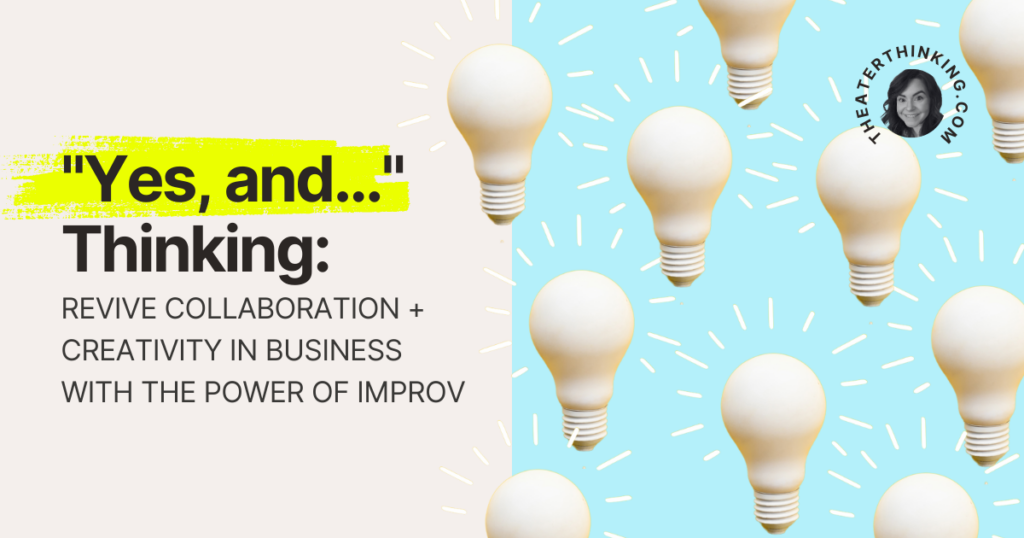“Yes, and…” Thinking: Unleashing Collaboration and Creativity in Business with the Power of Improv

In today’s ever-evolving business landscape, adaptability and innovation are crucial for success. One powerful approach to fostering a culture of collaboration and creative problem-solving is the “Yes, and…” thinking principle, which stems from the world of improvisational theatre. In this blog post, we’ll delve into the transformative potential of “Yes, and…” thinking for enhancing team dynamics, boosting communication, and driving business success. Let’s explore the magic of improv and learn how to harness this mindset for the benefit of your organization.
What is “Yes, and…” Thinking?
“Yes, and…” is a core principle of improvisational theatre, where performers spontaneously create scenes or stories by building on each other’s ideas. The concept is straightforward: when presented with an idea, you accept it (the “Yes” part) and then expand on it (the “and” part). This approach cultivates a supportive, open-minded environment where creativity flourishes.
As famed improviser and comedian Tina Fey once said, “The fun is always on the other side of a ‘yes.’” In a business setting, “Yes, and…” thinking encourages teams to embrace new ideas, work together effectively, and devise innovative solutions to problems.
The Benefits of “Yes, and…” Thinking in Business:
1. Enhanced Collaboration
By accepting and building on the ideas of others, team members feel heard and valued. This fosters a more collaborative work environment, where everyone is eager to contribute and share their perspectives. As legendary improviser Del Close noted, “Fall, then figure out what to do on the way down.”
2. Greater Creativity
“Yes, and…” thinking ignites creativity by prompting team members to explore new possibilities and think unconventionally. As ideas are expanded upon, inventive solutions can emerge, propelling business growth and success.
3. Improved Problem-Solving
Facing challenges with a “Yes, and…” mindset encourages team members to tackle problems from various angles and collaborate to find effective solutions.
4. Stronger Communication
Embracing “Yes, and…” thinking promotes open and honest communication, as team members feel comfortable sharing their ideas without fear of judgment or rejection.
Psychology data supports the effectiveness of “Yes, and…” thinking in business. A study published in the Journal of Experimental Social Psychology demonstrated that when individuals adopt a “Yes, and…” mindset, they exhibit increased creativity and cognitive flexibility, leading to more innovative solutions (1).
How to Implement “Yes, and…” Thinking in Your Business:
1. Cultivate a Culture of Openness
Create an environment where team members feel at ease sharing their ideas and opinions. Encourage group discussions, brainstorming sessions, and open forums for employees to express themselves.
2. Emphasize Active Listening
Ensure that everyone genuinely listens to one another’s ideas before responding. This can be achieved by paraphrasing or summarizing the speaker’s input before contributing your own thoughts.
3. Foster Collaboration over Competition
Promote a team mentality that values collaboration over individual accomplishments. Recognize and reward collaborative efforts and teamwork.
4. Provide Training and Workshops
Consider offering improv workshops or team-building exercises that focus on “Yes, and…” thinking to help your team develop these skills.
5. Lead by Example
As a leader, incorporate “Yes, and…” thinking into your own communication and problem-solving approaches. This sets the tone for your team and creates a positive work environment.
Embracing “Yes, and…” thinking can unleash the power of collaboration and creativity within your team, leading to enhanced communication, innovative problem-solving, and ultimately, business success. Drawing inspiration from the world of improvisational theatre is not only beneficial but transformative for your organization.
As you adopt this game-changing mindset, you’ll witness your team’s potential soar and your business thrive. Remember the wise words of comedian and improviser Amy Poehler, “Listen, say ‘yes,’ explore, and be kind.” So, say “yes” to this powerful mindset and watch your team reach new heights of success in the business world. The stage is set, and it’s time for your organization to stand out from the competition.